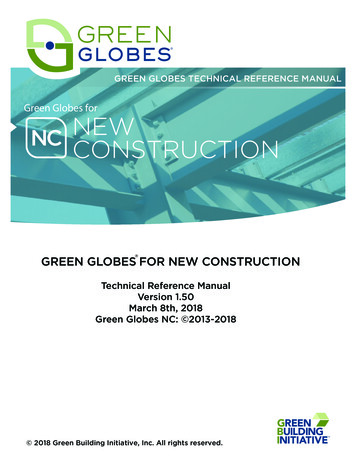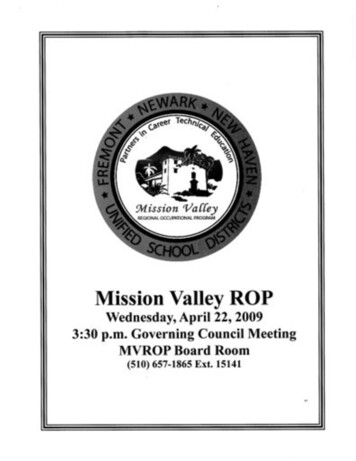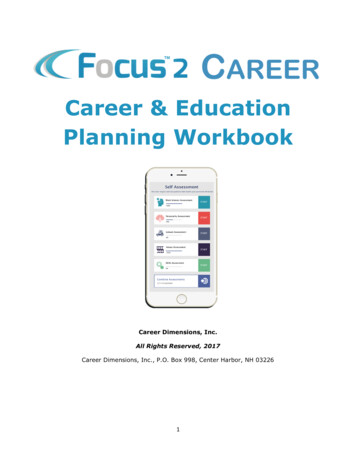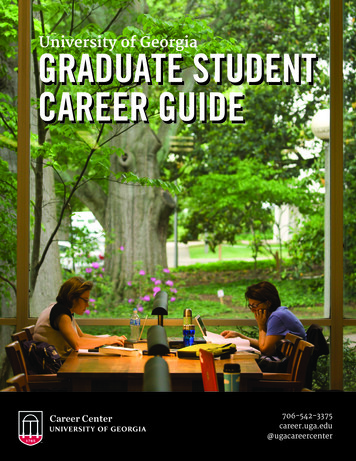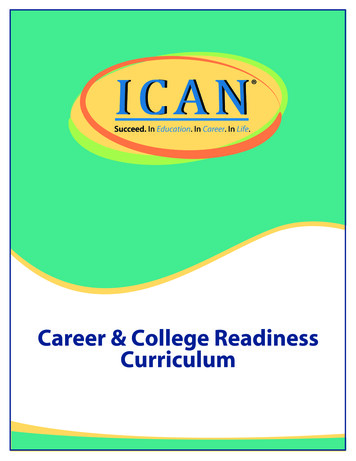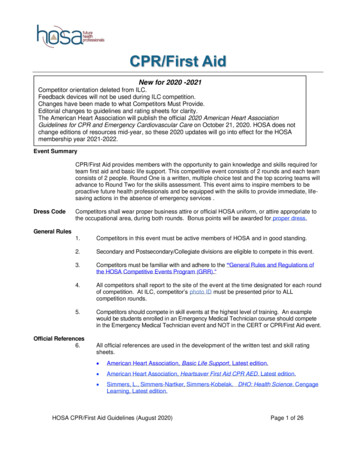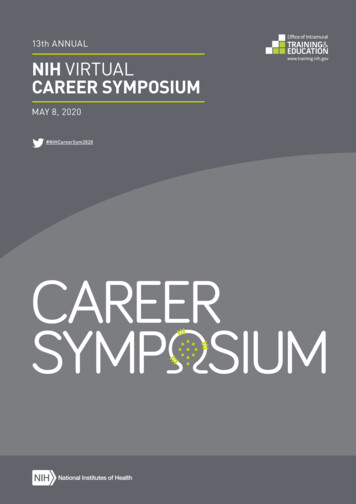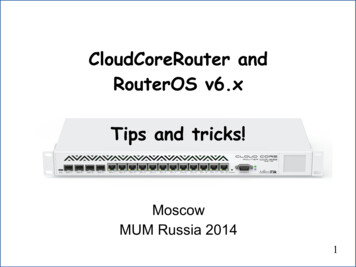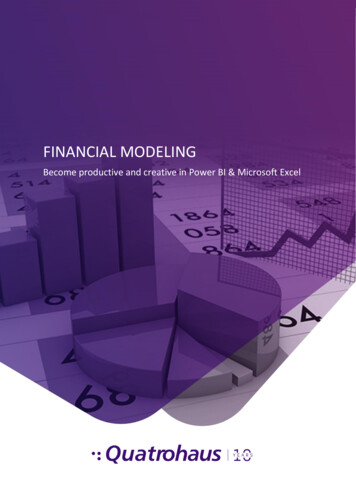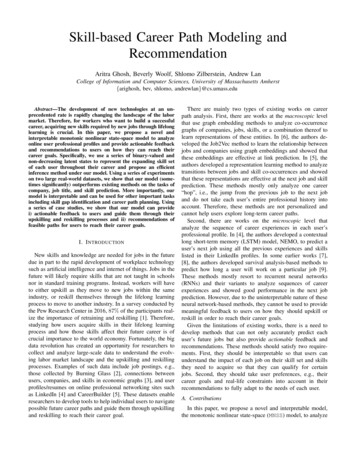
Transcription
Skill-based Career Path Modeling andRecommendationAritra Ghosh, Beverly Woolf, Shlomo Zilberstein, Andrew LanCollege of Information and Computer Sciences, University of Massachusetts Amherst{arighosh, bev, shlomo, andrewlan}@cs.umass.eduAbstract—The development of new technologies at an unprecedented rate is rapidly changing the landscape of the labormarket. Therefore, for workers who want to build a successfulcareer, acquiring new skills required by new jobs through lifelonglearning is crucial. In this paper, we propose a novel andinterpretable monotonic nonlinear state-space model to analyzeonline user professional profiles and provide actionable feedbackand recommendations to users on how they can reach theircareer goals. Specifically, we use a series of binary-valued andnon-decreasing latent states to represent the expanding skill setof each user throughout their career and propose an efficientinference method under our model. Using a series of experimentson two large real-world datasets, we show that our model (sometimes significantly) outperforms existing methods on the tasks ofcompany, job title, and skill prediction. More importantly, ourmodel is interpretable and can be used for other important tasksincluding skill gap identification and career path planning. Usinga series of case studies, we show that our model can providei) actionable feedback to users and guide them through theirupskilling and reskilling processes and ii) recommendations offeasible paths for users to reach their career goals.I. I NTRODUCTIONNew skills and knowledge are needed for jobs in the futuredue in part to the rapid development of workplace technologysuch as artificial intelligence and internet of things. Jobs in thefuture will likely require skills that are not taught in schoolsnor in standard training programs. Instead, workers will haveto either upskill as they move to new jobs within the sameindustry, or reskill themselves through the lifelong learningprocess to move to another industry. In a survey conducted bythe Pew Research Center in 2016, 87% of the participants realize the importance of retraining and reskilling [1]. Therefore,studying how users acquire skills in their lifelong learningprocess and how those skills affect their future career is ofcrucial importance to the world economy. Fortunately, the bigdata revolution has created an opportunity for researchers tocollect and analyze large-scale data to understand the evolving labor market landscape and the upskilling and reskillingprocesses. Examples of such data include job postings, e.g.,those collected by Burning Glass [2], connections betweenusers, companies, and skills in economic graphs [3], and userprofiles/resumes on online professional networking sites suchas LinkedIn [4] and CareerBuilder [5]. These datasets enableresearchers to develop tools to help individual users to navigatepossible future career paths and guide them through upskillingand reskilling to reach their career goal.There are mainly two types of existing works on careerpath analysis. First, there are works at the macroscopic levelthat use graph embedding methods to analyze co-occurrencegraphs of companies, jobs, skills, or a combination thereof tolearn representations of these entities. In [6], the authors developed the Job2Vec method to learn the relationship betweenjobs and companies using graph embeddings and showed thatthese embeddings are effective at link prediction. In [5], theauthors developed a representation learning method to analyzetransitions between jobs and skill co-occurrences and showedthat these representations are effective at the next job and skillprediction. These methods mostly only analyze one career“hop”, i.e., the jump from the previous job to the next joband do not take each user’s entire professional history intoaccount. Therefore, these methods are not personalized andcannot help users explore long-term career paths.Second, there are works on the microscopic level thatanalyze the sequence of career experiences in each user’sprofessional profile. In [4], the authors developed a contextuallong short-term memory (LSTM) model, NEMO, to predict auser’s next job using all the previous experiences and skillslisted in their LinkedIn profiles. In some earlier works [7],[8], the authors developed survival analysis-based methods topredict how long a user will work on a particular job [9].These methods mostly resort to recurrent neural networks(RNNs) and their variants to analyze sequences of careerexperiences and showed good performance in the next jobprediction. However, due to the uninterpretable nature of theseneural network-based methods, they cannot be used to providemeaningful feedback to users on how they should upskill orreskill in order to reach their career goals.Given the limitations of existing works, there is a need todevelop methods that can not only accurately predict eachuser’s future jobs but also provide actionable feedback andrecommendations. These methods should satisfy two requirements. First, they should be interpretable so that users canunderstand the impact of each job on their skill set and skillsthey need to acquire so that they can qualify for certainjobs. Second, they should take user preferences, e.g., theircareer goals and real-life constraints into account in theirrecommendations to fully adapt to the needs of each user.A. ContributionsIn this paper, we propose a novel and interpretable model,the monotonic nonlinear state-space (MNSS) model, to analyze
online user professional profiles and provide i) actionablefeedback to users on skills they need to acquire and ii)recommendations on their future career path. Our model ismotivated by the observation that working on a job is notonly proof that the user has the skills required for the job, butalso a valuable opportunity for a user to acquire new skills.Our specific contributions are as follows:1) We use a series of stochastic, binary-valued latent statesto characterize whether or not a user masters a skill ateach point in their career. We also restrict them to benon-decreasing over time to capture users’ expanding skillsets during their careers. We show that MNSS (sometimessignificantly) outperforms baseline methods on the tasksof company, job title, and skill prediction, using two largedatasets collected from LinkedIn and Indeed.2) We formulate the task of skill gap identification as anoptimization problem that can be solved to find a smallset of skills a user needs to improve the most to achievetheir desired career goal. We use several case studies todemonstrate that the identified skill gap can be used toprovide actionable feedback to users on their upskillingand reskilling processes.3) We formulate the task of career path recommendationas a path planning problem that can be (approximately)solved to find feasible paths a user can follow towardstheir ultimate career goal. We use several case studiesto demonstrate that the identified (approximately) optimalcareer paths can be used to provide practical career recommendations to users.We also acknowledge a limitation of our work in that thedata we analyze does not contain counterfactual information,i.e., job offers that users turned down or jobs they did notqualify for. Therefore, we can only analyze the observedcareer decisions made by each user and can neither takereal-life constraints they faced into account nor study userqualifications. Moreover, our career path recommendations aregenerated from historical user career path data and may bebiased. Therefore, we emphasize that our recommendationscan augment, but not replace, the decision-making processof a user throughout their career. Throughout the paper, weuse only professional/educational experiences of users forforecasting; we do not use any user (such as demographic)information for any of the tasks. 1B. Related WorkThe latent state-space model is a generic framework formodeling sequential data. Recently, deterministic RNNs andtheir modern versions such as LSTMs and gated recurrentunits (GRUs) have shown remarkable performance on mostsequential data modeling tasks including speech modeling,language processing, and video understanding [10]. Many ofthe previous career modeling works use RNNs; for example,NEMO uses an LSTM with contextual inputs to predict auser’s next career move [4].1 Ourcode is available at https://github.com/arghosh/MNSS.A common alternative to RNNs is to use models withstochastic latent states such as hidden Markov models(HMMs) or linear state-space models (L-SSMs), which offerinterpretable latent state transition and observed state emissionfunctions [11]. Moreover, stochastic models such as HMM/LSSM are more appropriate for capturing randomness in thedataset than deterministic models such as RNNs [12]. However, HMM and L-SSM have simple (discrete or linear) latentstates and can not capture the nuance in large, noisy realworld datasets. Lately, many advances have been made onnonlinear stochastic state-space models using the variationalprinciple [12], [13]. However, exact inference is intractable innonlinear state-space models. Following prior work, we learnthe parameters in MNSS by maximizing the so-called evidencelower bound (ELBO) [14].II. P ROBLEM F ORMULATIONi We denote the career profile of user i as Tiii[E1 , . . . , ETi ], S , with Ti experiences in their career trajectory and Eti denotes the tth experience (either professional oreducational). S i {si1 , . . . , siMi } denotes the user’s listed skillset and sij denotes the j th observed skill, with a total of Miobserved skills. Each educational experience contains information on e.g., School, Degree, Major, Start Time, and Duration,whereas each professional experience contains information one.g., Company, Job Title, Start Time, and Duration. There isno ordering among the skills listed in the observed skill set.Moreover, in most user profiles on major online professionalnetwork websites, there is no information on when the useracquired each skill in their career. Instead, the listed skill setis only a snapshot of their (evolving) true skill set captured atthe time the profile is accessed. Therefore, we do not use theseobserved skills to predict a user’s professional experiences likethe work in [4].Our goal is to develop a model for user career paths thatcan not only i) predict the career path of each user but alsoii) provide actionable feedback and career recommendationsto users to help them make important career decisions. In theremainder of the paper, we omit the superscript i for user i forsimplicity of exposition when we discuss one user. We startby defining two prediction tasks that will help us model usercareer paths.1) Company and Job Title Prediction: Predict ct , thecompany, and ot , the job title of a user’s next professional experience, given their previous experiences, i.e.,[E1 , . . . , Et 1 ].2) Skill Set Prediction: Predict a user’s listed skill setS {s1 , . . . , sM }, given their entire career history, i.e.,[E1 , . . . , ET ].We can adopt many black-box models for these predictiontasks. However, due to their uninterpretable nature, thesemodels cannot be used to provide actionable feedback andmeaningful career recommendations to users. Therefore, wedefine three auxiliary tasks that an interpretable model shouldbe able to tackle:
neer2003200720092013Python,C, C ,CloudComputing,Hadoop,ScalabilityFig. 1: The structure of the MNSS model and an example userprofile with T experiences.3) Skill Acquisition Process Reconstruction: Infer the (unobserved) skill sets, St S, of each user after each pastcareer experience. These predicted skill sets will help usto reconstruct the skill acquisition process throughout theuser’s career.4) Skill Gap Identification: Identify the skill gap a user isfacing, i.e., a list of skills that the user needs to acquire orimprove on to reach their desired career goal (a company,job title pair).5) Career Path Recommendation: Find feasible career pathsthat connect a user’s current career state to their career goal.These career paths consist of professional experiences thatare attainable and ultimately lead the user to their desiredcareer goal.We start by outlining a generic latent state-space modelframework for tasks (1) and (2) defined above. In Section III,we propose the interpretable MNSS model that is capable ofcompleting both these tasks and the auxiliary tasks (3), (4),and (5) defined above.A. Latent State-space Models for Career Experience Predictionused as input into the next latent skill state. We do not predictthe duration of professional experiences, although that can bemodeled using point processes [15]. Instead, we use as partof the input states to learn how the duration of a professionalexperience impacts a user’s skills.This latent state-space model has two key components:a latent skill state transition model p(zt z1:t 1 , u1:t ) andan observed career experience emission model p(xt zt ). Thetransition model characterizes how each professional experience impacts the latent skill state of the user, i.e., howdoes a user acquire new skills and improve existing skillsin an on-job setting. We note that there are other ways foruser upskilling, such as going through training programs andtaking online courses; however, since they are not often listedin online user professional profiles, we do not model themwith our transition model. The emission model characterizeshow latent skill states decide a user’s next career experience.Therefore, we use the transition model to estimate a user’scurrent latent skill states from their past experiences and thenuse the emission model to predict their next career experience.We also introduce an additional emission model p(S zT 1 ) topredict a user’s listed skill set given their entire career path.Our goal is to learn these transition and emission models fromreal-world user career profiles.III. M ETHODOLOGYIn this section, we detail the MNSS model for user careerpath modeling. Black-box neural network-based models aregenerally not interpretable, which means that they can excel atprediction while being unable to provide actionable feedbackto users. For example, since the latent states in these modelsare usually not associated with a user’s mastery level of anyobserved skills, they cannot be used to recommend a userwhich skills they should acquire in order to reach their careergoal.In order to enhance interpretability, we make a key assumption: a user’s skill mastery increases over time as they havemore career (either educational or professional) experiences.Therefore, we place a monotonic constraint on the latentskill states of each user. Moreover, typical state-space modelsuse continuous latent states that are not easily interpretable.Therefore, we use binary-valued random variables as the latentskill states in MNSS that indicate whether a user masters alatent skill or not. In what follows, we first lay out the MNSSmodel and then detail a method for efficient approximateinference using a novel monotonic GRU module.As shown in Figure 1, we adopt a generic latent state-spacemodel to analyze sequences of professional experiences in usercareer paths. The key component of this model is to use a setof latent states, zt RD , t 1, . . . , T , to characterize a setof unobserved, evolving variables that dictate the user’s careerexperience at each time step. At each time step, there is aninput to the latent state, denoted as ut , and an observed outputfrom the latent state, denoted at xt . Under most real-worldsettings, the observed output from the last time step is usedas the input to the next time step, i.e., ut xt 1 , except forthe first time step where there is no input; we initialize z1 toan all-zero vector. 2 In our problem setting, the latent statevariables zt correspond to the latent skill states of each userat each point in time, and the observed output variables xtcorrespond to the observed career experiences of the user atthat time. Since our goal is to predict professional experiences,we omit educational experiences at the output, but they are stillpθ (x1:T , z1:T u1:T ) pθz (z1 )2 In our experiments, we found that setting z to a learnable parameter1vector did not lead to improved prediction performance.where pθz (·) is the latent skill state transition model andpθx (·) is the career experience emission model; θz and θxA. Monotonic Nonlinear State-space ModelExcluding the likelihood of the listed skill set (which wedetail in Section III-B0c), the joint probability of all careerexperiences in a user’s profile and their corresponding latentskill states is given byQTt 2pθz (zt zt 1 , ut )QTt 1pθx (xt zt ),
denote the set of parameters in these models, respectively,and θ {θx , θz } denotes the set of all model parameters.We exclude the term pθz (z1 ) from our analysis since it isthe same for all users and does not impact our predictions. Asmentioned above, we make two novel model choices: First, weuse binary-valued discrete random variables as the latent skillstates, i.e., zt [zt,1 , . . . , zt,D ] {0, 1}D , where D denotesthe number of latent skills. In this setup, zt,j 0 1 means thatthe user masters latent skill j 0 after the tth experience. Second,we constraint the latent skill states to be non-decreasing, i.e.,zt 1 zt 3 , where the inequality operates element-wise onvectors. Under these model choices, zt,j 0 1 and zt 1,j 0 0means that the user acquired latent skill j 0 after the tthexperience, i.e., by working a job at a company for someduration (in case of a professional experience).B. Approximate θ (z1:T x1:T , u1:T ) in MNSS is computationally intractable.Therefore, following [12], [13], we use an auxiliarydistribution qφ (z x, u) (referred to as an recognition networkand usually parameterized by an RNN) with parameters φ,to approximate the true posterior. We perform approximateinference by maximizing the ELBO on the marginal observeddata log-likelihood given bylogpθ (x1:T u1:T ) L(θ, φ) Eqφ (z1:T x1:T ,u1:T ) log pθx (x1:T z1:T ) β DKL (qφ (z1:T x1:T , u1:T ) pθz (z1:T u1:T )),with respect to the model parameters θ and the recognitionnetwork parameters φ [14]. Here, qφ (z1:T x1:T , u1:T ) is theapproximate posterior distribution of the latent states andpθz (z1:T u1:T ) is its prior distribution. The first term is thereconstruction loss of the observed data sampled from theapproximate posterior distribution, whereas the second termis the KL divergence between the approximate posterior distribution and the prior distribution. The parameter β 0controls the balance between the reconstruction loss andthe KL divergence loss. Using the d-separation criterion inFigure 1, we can decompose the prior distribution asQTpθz (z1:T u1:T ) pθz (z1 ) t 2 pθz (zt zt 1 , ut ),and the approximate posterior distribution asQTqφ (z1:T x1:T , u1:T ) qφ (z1 ) t 2 qφ (zt zt 1 , xt , ut ).To approximate qφ (zt zt 1 , xt , ut ), we need to sample zt 1first. One option is to use ancestral sampling to approximateqφ in a way that is similar to the structured inference methodfor nonlinear state-space models [12], [13]. However, ancestralsampling is slow due to its sequential nature and has highvariance in its estimates [16]. Therefore, we employ anotherfactorization of the approximate posterior distribution where3 In terms of the latent skill state transition model, the monotonicconstraint can be stated as pθz (zt zt 1 , ut ) 0 if j 0 such that zt 1,j 0 zt,j 0 .the distribution of zt does not condition on zt 1 , to avoidsampling. We observe that the variable zt depends on u1:t andxt when zt 1 is unobserved. Using recurrence, we can equivalently write qφ (zt zt 1 , xt , ut ) qφ (zt xt , u1:t ). Since xt ut 1 , we have qφ (zt xt , u1:t ) qφ (zt u1:t 1 ). Similarly, wecan write the prior as pθz (zt zt 1 , ut ) pθz (zt u1:t ). Thefinal ELBO becomes:L(θ, φ) PT βt 1Eqφ (zt u1:t 1 ) log pθx (xt zt )PTt 1DKL (qφ (zt u1:t 1 ) pθz (zt u1:t )).(1)Thus, given the input states up until time step t and the currentoutput state xt , the recognition network qφ (·) predicts thedistribution of the latent state zt . On the other hand, giventhe input states up until the current time step, u1:t , the priornetwork pθ predicts the distribution of current latent state zt .The KL divergence term regularizes the recognition networkso that it is close to the prior distribution [14]. If we replace theapproximate posterior qφ (zt u1:t 1 ) with the prior, pθ (zt u1:t )in Eq. 1, the ELBO reduces to the log-likelihood, which is theobjective in maximum likelihood estimation (MLE):LM LE (θ) PTt 0Epθz (zt u1:t ) log pθx (xt zt ).In our experiments, we found that adding this objective tothe ELBO improves training stability [10]. Thus, the finalobjective that we maximize for the career experiences of allusers isP iii L (θ, φ) αLM LE (θ),where α 0 is a tunable parameter. We learn the recognitionnetwork parameters φ and the generative model parameters θsimultaneously using stochastic gradient descent [14]. Afterthe model parameters are trained, we use the learned priormodel pθz (zt u1:t ) to compute the distribution of the latentskill state zt , which is used to predict the user’s next careerexperience, xt .a) The monotonic gated recurrent unit: We now detailour choice for the recognition and prior networks for theapproximated posterior distribution and the prior distribution.Since the latent state zt is a binary-valued vector, we characterize it as Bernoulli random variables with success probabilitiespθz (zt u1:t ) γ t [0, 1]D for the prior model. We use anRNN-type model, gθz , to characterize the latent skill state transitions as γ t gθz (γ t 1 , ut ). Similarly, for the approximateposterior model, we have qφ (zt u1:t 1 ) κt [0, 1]D andanother RNN-type model, gφ , where κt gφ (κt 1 , xt ).Common RNN variants such as LSTMs and GRUs do nothave monotonic latent states. Therefore, we propose a newvariant of GRU, which we dub the monotonic GRU (MGRU),to model the latent skill state transitions. In the context ofthe prior, the MGRU is defined as (the approximate posteriorfollows the same structure with a different set of parameters)γ t γ t 1 (1 γ t 1 )ot ,(2)
whereanddenotes element-wise multiplication between vectorskt σ(Wk ut Uk γ t 1 ),rt σ(Wr ut Ur γ t 1 ),ot σ(Wo ut Uo (rtγ t 1 ))kt ,(3)where σ(x) 1/(1 exp( x)) is the sigmoid function andW, U denote parameter matrices. The γ t 1 term in Eq. 2corresponds to the expected value of the latent skill statesafter time step t 1; since γ t 1 [0, 1]D , we can interpret(1 γ t 1 ) [0, 1]D as the skill deficiency of the user(relative to full mastery of all latent skills, i.e., γ 1).ot [0, 1]D corresponds to the portion of the skill deficiencygap being filled by the professional experience at time step t.Therefore, it is easy to see that γ t γ t 1 . We use a gatingstructure similar to that in GRUs [10] for the recurrence inEq. 3; kt , rt , ot correspond to the update gate, reset gateand update value components of GRUs, respectively. We notethat in addition to being non-decreasing, another advantage ofMGRU is that the gradients do not vanish due to the additiverecurrence relation in Eq. 2. The inference procedure for timestep t is summarized in Figure 2.PriorNetworkRecognitionNetworkReconstruction LossFig. 2: Visualization of the approximate inference method.b) Sampling: The KL divergence between the twoBernoulli distributions qφ (zt u1:t 1 ) and pθz (zt u1:t ) can becomputed in closed-form, so the gradient of the KL divergenceterm can back-propagate through the parameters φ and θ. Tocompute the expected reconstruction loss, however, we needto sample from qφ (zt u1:t 1 ). Due to the discrete nature ofthe latent state z, we can not use the reparameterization trickto sample from qφ . Therefore, we can use the Gumbel-softmaxtrick, which allows us to obtained biased samples from qφ [17].In practice, we found that setting ẑ γ, i.e., to its expectedvalue and avoid sampling leads to comparable model fittingquality with lower empirical computational complexity.c) Emission models: The output state at time t is xt Et 1 (ct , ot ), where ct , ot are one-hot encoded vectorsrepresenting the company and the job title for the user’sprofessional experience at time step t. We use learnableembedding modules for all the fields including companies,job titles, and skills; the embedding modules ec (k) RE ,eo (l) RE , es (j) RE project the k th company, lth job title,and j th observed skill to an embedding space of dimension E,respectively.For the task of predicting the next professional experienceof a user, we treat the company and job title fields separately.We use nonlinear embedding modules (parameterized by fullyconnected neural networks) fc (·) and fo (·) to map the latentskill state zt into the embedding space of companies and jobtitles. We then minimize the combined cross-entropy objectivewith the softmax emission function p(xt zt ) for a (company,job title) pair as o (l) fo (zt ))c (k) fc (zt )) log PMexp(e, log PMexp(eco0 0 k0 1exp(ec (k ) fc (zt ))l0 1exp(eo (l ) fo (zt ))where Mc , Mo are the number of unique companies andjob titles, respectively. However, since these numbers arelikely very large, the denominators in the loss function cannotbe computed efficiently. Therefore, we employ a negativesampling approach and convert the multi-class classificationproblem into a series of binary classification problems, usinga small number of randomly sampled companies and job titlesas negative examples [18], [19]. Concretely, we minimize thefollowing objective for company prediction:PN log(σ(ec (k) fc (zt )) k0s 1 log(σ( ec (k 0 ) fc (zt )),where k 0 indexes a total of Ns negative samples from a uniform distribution among companies that do not correspond tothe user’s professional experience at time step t. The objectivefor job title prediction is defined similarly. We include thisobjective term for professional experiences but not educationalexperiences.For the task of predicting the observed skill set S, weuse a two-step approach. First, we take the user’s currentprofessional experience xT and use it to estimate the user’scurrent latent skill state, zT 1 , from pθz (zT 1 x1:T ). Second,we use a (linear) embedding module fs (·) parameterized bythe matrix Ws RD E to map zT 1 [0, 1]D into theembedding space of observed skills asPDfs (zT 1 ) j 0 1 zT 1,j 0 [Ws ]j 0 Ws zT 1 RE ,thwhere [Ws ]j 0 denotes the vector in the j 0 row of Ws , i.e.,the embedding of latent skill j 0 . Since a user’s observed skillset contains multiple skills, we predict these observed skillsby minimizing the following objective:XX log(σ(es (j) fs (zT 1 )) log(σ( es (j) fs (zT 1 )).j Sj S/Since the total number of unique skills is significantly largerthan the number of observed skills for each user, we employnegative sampling again to randomly select a small subset ofunobserved skills in the second term of the loss function abovefor each user.C. Career Path RecommendationUsing MNSS, we can trace a user’s latent skill states zt overtime and compute their probability of attaining any job at anycompany at any point in time. These capabilities enable usto study career paths that connect a user to their desired job.We define the career goal of a user as a (company, job title)
Dataset# Users# Experiences# Companies# Job Titles# SkillsLinkedInIndeed1, 136, 2313, 945, 0406, 281, 57226, 009, 71189, 12685, 42756, 77350, 21916, 97617, 836TABLE I: Dataset statistics.pair (c , o ); given their experiences until time step t, ourtask is to plan a career path, i.e., intermediate (company, jobtitle) pairs, for them to eventually reach their career goal. Forexample, after completing a Bachelor’s degree in Economics,a user is working in Deloitte Ltd. as an Analyst; our goal is torecommend a path consisting of a series of intermediate career“hops” that has the best chance of leading them to their careergoal, which is to become a partner at Goldman Sachs.Formally, for each user, given their experiences (both educational and professional) for the first t time steps as [E1 , . . . , Et ],our goal is to find a path [Êt 1 , . . ., ÊG ], where ÊG (c , o )is their career goal, with an arbitrary number of intermediatehops [Êt 1 , . . . , ÊG 1 ]. For the path to be feasible to the user,we maximize the likelihood of the entire career path, includingeach intermediate hop, asmax[Êt 1 ,.,ÊG 1 ]QGt0 t 1p(Êt0 E1:t , Êt 1:t0 1 ),(4)where we maximize over all paths consisting of valid combinations of companies and job titles.a) Conditional optimal path: An additional relevant realworld scenario is that a user has several options for theirnext career hop and need to choose one. For example, aftercompleting a Bachelor’s degree in Computer Science, a userhas offers to join a Ph.D. program in Economics, an MBA program, or a banking company as a developer. They must makea decision on which offer to accept in order to maximize thechance of reaching their final career goal, which is to becomea partner at McKinsey & Co. We denote these K choices1K(after time step t) as {Êt 1, · · · , Êt 1} and recommend theuser to choose the one that maximizes the likelihood of theirsubsequent career path to the career goal asA. DatasetWe use two publicly available datasets containing usercareer profiles, extracted from LinkedIn4 and Indeed5 . A userprofile consists of educational and professional experiencesalong with their skill set. Table I lists the number of userprofiles, experiences, and unique skills, companies, job titlesfor both datasets. In each dataset, the numbers of uniqueentities, incl
3) Skill Acquisition Process Reconstruction: Infer the (un-observed) skill sets, S t S, of each user after each past career experience. These predicted skill sets will help us to reconstruct the skill acquisition process throughout the user’s career. 4) Skill Gap I
